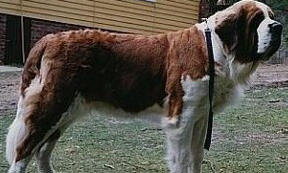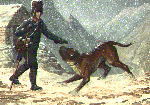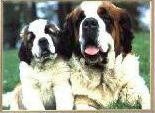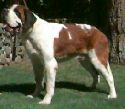
 Saint Bernard
Saint Bernard

ST. BERNARD
Shrouded in legend and the mists of time, the origin of the Saint Bernard is subject to many theories.
It seems probable that the Saint Bernard developed from stock that resulted from the breeding of heavy Asian "Molosser" (canis molossus), brought to Helvetica by Roman armies during the first two centuries A.D., with native dogs which undoubtedly existed in the region at the time of the Roman invasions. They were apparently well established ny 1050 A.D..
 A powerful good-natured dog. Famous for being a rescuer of those stranded in the high country. When the dog would come upon a victim it would instinctively lie down next to the victim to provide warmth.
A powerful good-natured dog. Famous for being a rescuer of those stranded in the high country. When the dog would come upon a victim it would instinctively lie down next to the victim to provide warmth.
Height: dogs should be 27 1/2 inches at the shoulders; females 25 1/2 inches at the shoulders.
"The St. Bernard"
 This beautiful Breed was brought to the Alps, in the first two centuries A.D., with the Golden Lion dogs of Rome and also other different breeds, that the Romans picked up along their travels
This beautiful Breed was brought to the Alps, in the first two centuries A.D., with the Golden Lion dogs of Rome and also other different breeds, that the Romans picked up along their travels
The Breed has been known by many names,the most famous being "The Barryhund"
At the height of the Great St. Bernard Pass, 2469 m (8100 ft.) above sea level, a hospice was founded by monks in the 11th century as a refuge for travellers and pilgrims. Large mountain dogs have been kept there for watch and protection since the middle of the 17th century. The existence of such dogs has been documented in paintings and drawings dating back to 1695 and in written official documents of the Hospice since 1707.
These dogs were soon in service as companion dogs for the monks, being especially deployed as rescue dogs for travelers lost in snow and fog. Numerous chronicles, published in many languages, as well as verbal reports by the soldiers of Napoleon who transited the Great Pass with him in 1800, tell of the many lives saved by these dogs in the face of "the White Death". The fame of the St. Bernard then known as the "Barry-dog", spread throughout Europe in the 19th century, and the legendary dog "Barry" became the epitome of the rescue.
 Nobody can say when the breed actually was first really recoginised, all we have are the Hospice Records.
Nobody can say when the breed actually was first really recoginised, all we have are the Hospice Records.
The Monks under the Rev.Bernard De Menthon. He founded the famous Hospice, these Monks really put in some very hard work and training of the Saint Bernard.
They only used male dogs at the Hospice, for the obvious reason, these great men took various dogs and turned them into the beautiful rescue dog, that we know as the Saint Bernard of to-day. This Breed is super intelligent, they have a wonderful trait, such as they can smell 10'-20' under snow, not at all common with other breeds, except the Bloodhounds.
The females of the Breed were kept on Farms lower down the Alps. The work that the Holy Men and their dog's did is renowned throughout the World.
The Monks of the Monstery knew that they had a special job to do and they did it. These Holy Men didn't care what time, day or night, they were always ready to go out into the freezing weather, along with their dogs, to rescue poor lost travellers in the snow.
In those days they only used short coated dogs, the collars had two loops on them. No they were not used for the kegs, Sir Edwin Landseer painted the famous Rescue and he put a keg on the dog. This is how the barrel came about, now it helps to make money for the Rescues,the two loops were for carrying rolled blankets, whilst the Monks followed behind with the strechers for carrying the stricken traveller/s, back to the Hospice.
The direct ancestors of the St. Bernard were the large farm dog which were widely spread across the region, within a few generations after the establishment of the ideal type, they were bred into the present day breed. Heinrich Schumacher, from Holligen near Berne, Switzerland, was the first to document and provide pedigrees for his dogs.
In February 1884 the "Schweizerische Hundestammbuch" (SHSB), the Swiss Dog Stud Book, was opened. The very first entry was the St. Bernard "L�on", and the following 28 entries were also all St. Bernards.
The Swiss St. Bernard Club was founded in Basle on March 15th 1884. During the International Canine Congress of June 2nd 1887, the St. Bernard was officially recognized as a Swiss breed and the breed standard was declared as binding. Since that time the St. Bernard has been a Swiss national dog.
 Return to the Fridge door
Return to the Fridge door